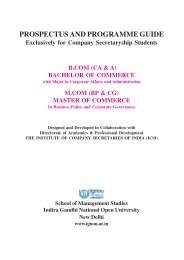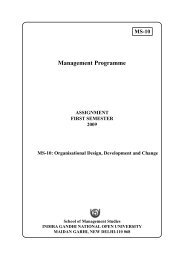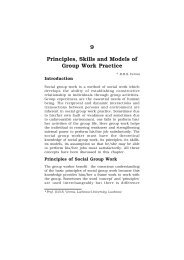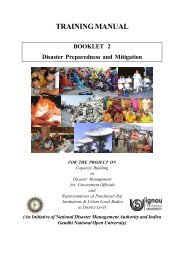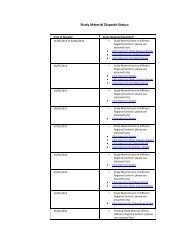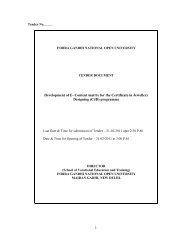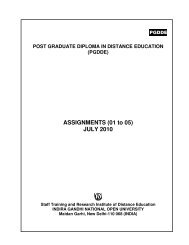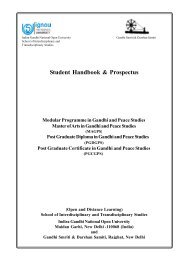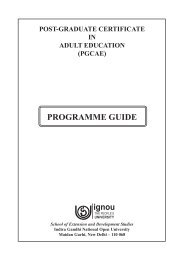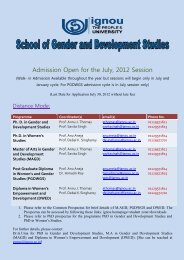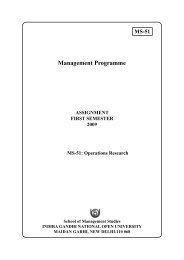Disaster Recovery and the Road Ahead - IGNOU
Disaster Recovery and the Road Ahead - IGNOU
Disaster Recovery and the Road Ahead - IGNOU
You also want an ePaper? Increase the reach of your titles
YUMPU automatically turns print PDFs into web optimized ePapers that Google loves.
INTRODUCTION TO THE BOOKLET<br />
<strong>Disaster</strong> Management meets its toughest test at <strong>the</strong> recovery stage. This is <strong>the</strong> phase when <strong>the</strong> relief<br />
work is over <strong>and</strong> <strong>the</strong> agencies involved in humanitarian aid are on <strong>the</strong>ir way out. The space that is<br />
created <strong>the</strong>reafter has to be filled by <strong>the</strong> affected community itself. This is also <strong>the</strong> time when national<br />
<strong>and</strong> international agencies need to involve <strong>the</strong>mselves full-fledgedly in disaster rehabilitation. What<br />
makes <strong>the</strong> task challenging is <strong>the</strong> different stages at which rehabilitation needs to be carried out; namely<br />
physical, social <strong>and</strong> psychological. The most crucial aspect is that of psychological recovery, as it<br />
requires tremendous adjustment on <strong>the</strong> part of victims <strong>and</strong> various stakeholders in <strong>the</strong> process of<br />
rehabilitation. This Booklet titled ‘<strong>Disaster</strong> <strong>Recovery</strong> <strong>and</strong> <strong>the</strong> <strong>Road</strong> <strong>Ahead</strong>’ deals with <strong>the</strong>se very aspects<br />
in detail.<br />
The Booklet, <strong>the</strong> 4 th <strong>and</strong> <strong>the</strong> last one of <strong>the</strong> Training Manual, is divided into 2 Sections. The first Section<br />
is on ‘<strong>Disaster</strong> <strong>Recovery</strong>’ <strong>and</strong> deals with <strong>the</strong> characteristics, principles <strong>and</strong> typology of rehabilitation. It<br />
brings out <strong>the</strong> reconstruction strategies for different disasters, especially <strong>the</strong> earthquakes. In <strong>the</strong> ‘Concepts<br />
to Remember’, <strong>the</strong> Section explains terms such as Alternative Cropping Pattern, Canal Irrigation, Crop<br />
Life Saving Techniques, Deforestation , Damageability, Desertification, Ductility, Gender, Monitoring,<br />
Evaluation, Retrofitting <strong>and</strong> Watershed Management. The constraints in disaster recovery are also<br />
dealt with. Section 2 is on <strong>the</strong> ‘<strong>Road</strong> <strong>Ahead</strong>’ <strong>and</strong> gives a futuristic perspective on disaster management<br />
by highlighting <strong>the</strong> crucial components of <strong>the</strong> Interface between <strong>Disaster</strong>s <strong>and</strong> Development, Sustainable<br />
Development Framework <strong>and</strong> Relief-Rehabilitation Development Continuum. Many new developments/<br />
initiatives taken by various organizations in disaster management, especially <strong>the</strong> NDMA have been<br />
brought out. Most importantly, this Section highlights <strong>the</strong> role of PRIs <strong>and</strong> ULBs under <strong>the</strong> 11 th <strong>and</strong> 12 th<br />
Schedules of <strong>the</strong> Constitution. The Booklet will come in h<strong>and</strong>y for you when you engage yourselves in<br />
disaster recovery tasks.



